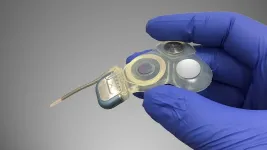(Press-News.org) A new modelling study published in Anaesthesia (a journal of the Association of Anaesthetists) shows that the UK's coronavirus vaccination program is already reducing daily deaths. However, reductions of hospital and intensive care (ICU) admissions will likely take several weeks longer, with large reductions seen by the end of March and continuing into April.
The study is by Professor Tim Cook (Consultant in Anaesthesia and Intensive Care Medicine, Royal United Hospitals Bath NHS Foundation Trust, Bath, UK, and Honorary Professor, School of Medicine, University of Bristol, UK) and Mr John Roberts, of the COVID-19 Actuaries Response Group*.
The UK's vaccination program is being rolled out at pace, and aims to have vaccinated close to 15 million people in the first four priority groups by next Monday, February 15. The latest data suggests the government will meet and possibly exceed this target. The first four priority groups include residents and staff in care homes for the elderly (group 1), people aged 80 years and over and frontline health and social care workers (group 2), people aged 75-79 years (group 3) and people aged 70-74 years and clinically extremely vulnerable adults (group 4).
The authors explain that the reason that vaccination will affect deaths, hospital admissions and ICU admissions at different rates is due to the different age ranges for each: the average (median) age of patients dying with COVID-19 is 83 years, whereas the average age of those hospitalised is 73 years and those admitted to intensive care is 61 years. Furthermore, around three quarters of COVID-19 deaths recorded in the UK so far have been in people aged 75 years and over. Thus, since vaccination is initially targeting mostly people aged 70 years and over, the first phase of vaccination will have a proportionally greater effect on deaths.
The authors explain that the model includes certain assumptions. These include complete take-up of the vaccine and complete success of the vaccine at preventing hospital admission or death. Current evidence suggests vaccine uptake will be near to 100% in higher risk groups (with most of groups 1- 4 already vaccinated) and that the vaccines are particularly effective at preventing disease progression; the model therefore represents a best-case scenario.
The model predicts that with most of groups 1- 4 vaccinated, daily deaths will reduce by some 88% by the second half of March. At the same time, hospital admissions will have fallen by around two thirds (66%) and ICU admissions by only a little more than one third (36%).
The authors also highlight the benefits that will be seen if high vaccination rates are continued into the next three priority groups: group 5 (all those aged 65 and over), group 6 (adults aged 16 to 65 years in an at-risk group) and group 7 (all those aged 60 years and over). The authors say: "Vaccinating through groups 5-7 in addition to groups 1-4 will have a substantial impact on all three factors: reducing deaths by 96%, hospital admissions by more than 80% and ICU admissions by almost two thirds."
At the current rate of progress, most people in groups 1-7 will have received their first dose by the end of March, so these reductions will be seen in the second half of April.
The study provides some support for the UK government strategy of delaying the second dose of vaccine, as within approximately three months half of the adult population can be vaccinated with their first dose. The authors say that this strategy "will optimise the impact of vaccination on deaths and healthcare service pressures". They add that the data generally supports the government's organisation of priority groups, and highlight that the decision to vaccinate health and social care workers early will support the hospitals and care services that are needed over a prolonged period as the pandemic is brought under control.
In addition, rapidly vaccinating groups 1-7 will reduce viral circulation in the community and this may reduce spread among the unvaccinated. The authors explain: "This in turn could reduce the evolutionary pressure on the virus, thereby reducing the risks of emergence of higher risk viral strains including those that may be able to evade the vaccines developed so far."
What is unclear is how best to proceed after groups 1-7 to have been vaccinated. Currently, the government strategy is to then move onto the final two groups: group 8 (all those aged 55 years and over) and group 9 (all those aged 50 years and over). However, the modelling shows that vaccinating these last two groups has a less significant impact on deaths, hospital and ICU admissions than the earlier groups 1-7. They say: "It may be that after the UK has vaccinated groups 1-7, vaccination priorities may reasonably be reconsidered. For example, to target high risk key workers, such as those involved in transport and education, to enable community control of transmission and accelerate the return to normality in some areas of public life."
Also, there has been extensive discussion in recent weeks about how countries can best share their vaccines to help shortfalls in other countries. The authors say: "Vaccination is a global imperative and once the UK has substantially reduced its COVID-19-related deaths, hospital and ICU admissions, it may also be rational and moral to consider whether UK stocks of vaccine might also be redistributed to support the global attempts at vaccination in countries with lower access to vaccines."
The authors say: "Our model matches the UK Government's estimates for mortality reductions very well. The model shows that the impact of vaccination on deaths due to COVID-19 will be much more rapid than the impact on hospital and ICU admissions. Our model suggests that the impact of vaccination on daily deaths due to COVID-19 will be substantial throughout February and March. The impact of vaccination on hospital and ICU admissions will initially be slower: these will not decrease substantially until late March, with reductions continuing throughout April."
They add: "The early prioritisation of healthcare staff and clinically vulnerable patients is likely to increase the impact of vaccination on hospital and ICU admissions and to also protect the healthcare service. An inflection point, when 50% of the adult population has been vaccinated - and when deaths have been reduced by 96% and hospital admissions by 80% - may be a useful point for re-evaluating vaccine prioritisation."
Dr Mike Nathanson, President of the Association of Anaesthetists, says: "This analysis allows us to predict the effect of the pandemic on anaesthetists and anaesthetic departments over the next few weeks and months. The huge pressure on all staff working in, and supporting, intensive care units will continue until at least the end of March. The severe toll on wellbeing, the stress and the fatigue have all been well documented. Further, with the acute care sector so busy, it is very likely that elective care cannot restart until after Easter at the earliest. The many, many patients whose surgery is on hold will continue to wait."
INFORMATION:
Anti-retroviral drugs are a vital tool in the prevention and treatment of HIV. A new study of pregnant women in Tanzania shows that life-long antiviral treatment also seems to prevent viral transmission from mother to baby. The results of the study, which was conducted in part by researchers at Karolinska Institutet in Sweden and published in Lancet HIV, make a promising contribution to the WHO's work with HIV prevention in low and middle-income countries.
Just over eight years ago, the World Health Organisation (WHO) issued recommendations known as Option B+ for a simpler and more effective prevention and treatment for HIV during and beyond pregnancy in low and middle-income countries.
One arm of the Option B+ programme involved ensuring that pregnant women with HIV ...
Researchers from North Carolina State University used a three-model approach to trace the between-farm spread of porcine epidemic diarrhea virus (PEDV), as well as to analyze the efficacy of different control strategies in these scenarios. The approach may enable farmers to be more proactive in preventing the spread of PEDV and to optimize their efforts to control the disease.
PEDV is a virus that causes high mortality rates in preweaned piglets. The virus emerged in the U.S. in 2013 and by 2014 had infected approximately 50 percent of breeding herds. PEDV is transmitted by contact with contaminated fecal matter.
"We wanted to compare three different models by using actual outbreak data in order to test their efficacy," says Gustavo Machado, assistant professor of population ...
To build a universal quantum computer from fragile quantum components, effective implementation of quantum error correction (QEC) is an essential requirement and a central challenge. QEC is used in quantum computing, which has the potential to solve scientific problems beyond the scope of supercomputers, to protect quantum information from errors due to various noise.
Published by the journal Nature, research co-authored by University of Massachusetts Amherst physicist Chen Wang, graduate students Jeffrey Gertler and Shruti Shirol, and postdoctoral researcher Juliang Li takes a step toward building a fault-tolerant ...
New research from the Indiana University Kelley School of Business shows first evidence that watching and learning from others can help reduce bias and improve decision-making.
The research, published END ...
MUSC Hollings Cancer Center researcher Yongxia Wu, Ph.D., identified a new target molecule in the fight against graft-versus-host disease (GVHD). Bone marrow transplant, a treatment for certain blood cancers, is accompanied by potentially life-threatening GVHD in nearly 50% of patients. A January 2021 paper published in Cellular and Molecular Immunology revealed that activating a molecule called STING may be a new approach to reduce GVHD.
Xue-Zhong Yu, M.D., professor in the Department of Microbiology and Immunology, focuses on understanding the intricate immune mechanisms that regulate GVHD development and anti-tumor activity.
Recently, STING (stimulator of interferon genes) has been highly studied in the context of cancer. Data from other groups has shown that STING activation ...
Irvine, CA - February 11, 2021 - Subconsciously, our bodies keep time for us through an ancient means - the circadian clock. A new University of California, Irvine-led article reviews how the clock controls various aspects of homeostasis, and how organs coordinate their function over the course of a day.
"What is fascinating is that nearly every cell that makes up our organs has its own clock, and thus timing is a crucial aspect of biology," said Kevin B. Koronowski, PhD, lead author and a postdoctoral fellow in Biological Chemistry at the UCI School of Medicine. "Understanding how daily timing is integrated with function ...
A Russian physicist and his international colleagues studied a quantum point contact (QCP) between two conductors with external oscillating fields applied to the contact. They found that, for some types of contacts, an increase in the oscillation frequency above a critical value reduced the current to zero - a promising mechanism that can help create nanoelectronics components. This research supported by the Russian Science Foundation (RSF) was published in the Physical Review B journal.
A persistent trend in the modern electronics, miniaturization has spurred demand for new nano-sized devices that boast advanced performance and leverage quantum effects with electrons ...
Getting around without the need to concentrate on every step is something most of us can take for granted because our inner ears drive reflexes that make maintaining balance automatic. However, for about 1.8 million adults worldwide with bilateral vestibular hypofunction (BVH) -- loss of the inner ears' sense of balance -- walking requires constant attention to avoid a fall. Now, Johns Hopkins Medicine researchers have shown that they can facilitate walking, relieve dizziness and improve quality of life in patients with BVH by surgically implanting a stimulator that electrically ...
CORVALLIS, Ore. - The songs of fin whales can be used for seismic imaging of the oceanic crust, providing scientists a novel alternative to conventional surveying, a new study published this week in Science shows.
Fin whale songs contain signals that are reflected and refracted within the crust, including the sediment and the solid rock layers beneath. These signals, recorded on seismometers on the ocean bottom, can be used to determine the thickness of the layers as well as other information relevant to seismic research, said John Nabelek, a professor in Oregon State University's College of Earth, Ocean, and Atmospheric Sciences and a co-author of the paper.
"People in the past have used whale calls to track whales and study whale behavior. ...
For some 15,000 years, dogs have been our hunting partners, workmates, helpers and companions. Could they also be our next allies in the fight against COVID-19?
According to UC Santa Barbara professor emeritus Tommy Dickey(link is external) and his collaborator, BioScent researcher Heather Junqueira, they can. And with a review paper(link is external) published in the Journal of Osteopathic Medicine they have added to a small but growing consensus that trained medical scent dogs can effectively be used for screening individuals who may be infected with the COVID-19 virus.
This follows a comprehensive survey of research ...






